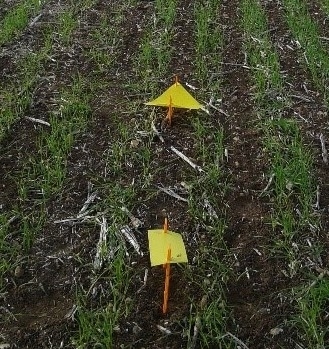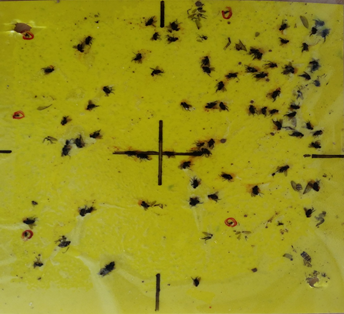By Prof. John Holland, GWCT Head of Farmland Ecology
This year will be the first that neonicotinoid seed dressings will no longer be routinely applied to cereal crops following their ban last year. This no doubt will be making many farmers rather nervous and reaching for a few cans of pyrethroid. Unfortunately, resistance to these products by the aphids is on the increase and will ultimately make them useless unless they are used prudently.
Moreover, these insecticides are also toxic to the beneficial insects that can help control aphids, especially the tiny money spiders, beetles and parasitic wasps that are active in the autumn. The webs of the spiders can be seen carpeting a field on dewy mornings, capturing flying aphids as they start to infest fields. The products are also highly toxic to aquatic insects if they get into water and with insect armageddon upon us they all need a helping hand.
Since last September GWCT and Agrii have been testing whether sticky traps could be used as monitoring tool to predict when and the levels of aphids invading fields in a pilot project funded by AHDB. At its simplest the sticky traps can be used in conjunction with the AHDB or Agrii BYDV Alert tools to indicate when aphids are arriving and so act as the trigger to start these tools.
These then calculate the number of day degrees using weather data until a foliar spray should be applied to halt the secondary spread of aphids, the ones most likely to spread BYDV across the field. A more advanced approach would be to develop a spray threshold perhaps in conjunction with a decision support system app. This second approach was beyond the scope of the current pilot study.


The work follows on from a GWCT study that we did in 2015. In this we found that yellow sticky traps on the ground were effective at capturing cereal aphids as they invaded the crop and that interestingly numbers were much higher in the headland areas of the field and quickly dropped off towards the centre.
To confirm how consistent this effect was across the country, we deployed sticky traps in over 60 fields, with traps at 5 and 70m from the crop edge. Overall three and half times as many aphids were caught on the traps 5m from the edge compared to 70m and in only 9 fields were they higher at 70m. To look at this in more detail were also set up a traps in a grid system at 40m intervals across two 10 ha fields. This again confirm that most aphids were located around the edges and in the areas of the fields closest to the prevailing wind (Fig. 1).
This could be expected as it is known that air currents flowing over boundary features then dip down into the field and aphids being weak flyers are carried on these currents. This offers the possibility of only spraying the headlands, but with LERAPS and the potential for drift into the field boundaries which are important overwintering sites for many insects and spiders, practically this poses some problems.


Fig 1. Trial examining spatial distribution of cereal aphids within a field, red crosses are aphid patches and blue circles are gaps without aphids.
We also found that there was huge variation in the levels of aphids invading each field and this even differed between fields on the same farm. Looking at the data for early to mid-November, in headland areas of 48 fields, no aphids were captured in 16% of the fields, <5 per trap per day were caught in 64% and 19% had more than 5 per trap per day.
From mid-November to early December, the same proportion had no aphids, 83% had less than 5 aphids and none had over this level. In the mid-field areas, there were fewer aphids with 24% having no aphids for both periods, 72% having less than 5% and only 4% had more than 5, but only early to mid-November. Such variation suggests that a field- or farm-based monitoring system could help reduce insecticide usage.
The levels of aphids alone is not the only important factor effecting whether BYDV will occur, but also the proportion infected with BYDV. Aphids were tested for virus presence for two of the fields with the highest numbers, however in one no infected aphids were found whilst the other had 5% infected. This level of infection is in agreement with other studies. Unfortunately the process of virus testing is quite complex and costly at present so cannot be used at present as a decision support tool.
If the sticky trap approach is to be taken up by farmers and agronomists it will be essential that the system is simple and easy to use and that the numbers of aphids can be accurately assessed. To look into this a number of farmers and agronomists kindly agreed to trial the method putting out 2 traps per field in several fields.
We gave them a very simple identification guide as we wanted to evaluate whether they could identify aphids with the most basic training. They liked the sticky trap approach although the practicalities of the system would need improvement if to be rolled out. However, they often either missed aphids or mis-identified them and so a better identification guide is needed with high quality pictures or even a video.
They recognised the need for field-specific monitoring and would be willing to use them in at least 4-5 fields on their farm. The approach certainly raised awareness about how variable aphid levels could be and in three cases, farmers reduced their insecticide usage based on the numbers they were seeing on the traps, even without a threshold.
In the project we were also hoping to explore the use of the a French infestation threshold to predict spray timings in a trial set up by Agrii using untreated seed. However, unfortunately the aphids failed to cooperate with very few infesting the plots, so that the threshold could not be tested. Two of the treatments were treated with insecticide which reduced BYDV damage to 0.25% compared to 4.9% when unsprayed, this translated into a significant yield gain of 0.51 t/ha.
Analyses are still underway and we will explore to what extent the type of tillage effected levels of immigrating aphids. When aphids are in the air they have some ability to direct their landing place and the presence of crop debris may help disguise the presence of the crop. Once in the crop minimum tillage and debris can also encourage natural enemies that can prevent them establishing.
Previous GWCT research has shown that some natural enemies are damaged by intensive tillage whilst crop debris offers a more diverse architecture on which spiders can spin their webs. Levels of natural enemies were sampled in some fields and this will be reported in my next blog. We also look at the extent to which the surrounding landscape effects the numbers of aphids dispersing across the landscape.
Research in the late 1980s and early 90s showed that areas nearer the coast had more aphids, whilst having more arable land reduced the risk. More recent studies in France showed that maize can increase aphid levels in the landscape. Aphid populations may have changed though since these early studies. The GWCT 50-year long Sussex study has shown that cereal aphids on crops in summer have steadily declined and are now at their lowest levels.
To reduce the risk of BYDV this year there are some options available. Aphids can survive between crops if there is a green-bridge, annual meadow grass in particular can harbour aphids. Removing this before cultivating will help. The evidence that minimum tillage will reduce aphids isn’t yet clear, but we know from other studies that intensive tillage practices can damage populations of ground-living beneficial insects.
Drill later and thereby the risk of aphids infesting and spreading before cold weather halts their progress. Finally, if you have to use pyrethroids follow the guidelines for resistance management. Only grain aphids have developed resistance so far, but this was the predominant species in our studies that covered southern and eastern England and the Midlands. Bird-cherry oat aphids are considerable more important in south-west England (see IRAG publication)
The AHDB project 21120077 Field monitoring of BYDV risk in winter cereals (pilot study) is run by GWCT and Agrii with in-kind funding from Agrii and BASF.



Get the inside track on soil and water research
Priced now at just £4.95 (50% off), The Soil & Water Balance is a handy paperback which provides the inside track on soil and water research.
Presented in a Q&A style, much like our popular Moorland Balance, this 100-page book looks at the problems and solutions on topics ranging from erosion and contamination, to the impact on songbirds and other wildlife.
Combining years of research at the GWCT's Allerton Project demonstration farm with tens of external scientific papers, this is a fascinating study of how farming can adapt to the challenges it currently faces.
View Book >
or
Buy Now - £4.95 >
100% Secure. All Credit & Debit cards, PayPal, Apple Pay and Google Pay accepted.
